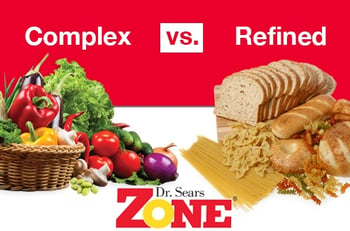Think you’re pretty knowledgeable when it comes to carbohydrates? You may be surprised about the misconceptions surrounding this nutrient. Let us help separate the facts from the fiction.
- Carbs grow in the ground, protein moves around
Most people are surprised to learn that carbohydrates don’t only pertain to bread, rice and pasta. Outside of those sweet treats you find in your local bakery or the inner aisles of the supermarket, fruits, vegetables and legumes, are carbs too. In the words of Dr. Sears, a good way to remember the difference between carbs and protein is that “carbohydrates grow in the ground and protein moves around.”
- Carbohydrates are not essential nutrients, but you need them in your diet
In theory there are no “essential” carbohydrates since the body can convert protein into carbohydrates. That being said you do need a moderate amount of carbohydrates in your diet as your brain relies solely on glucose (a breakdown product of carbohydrates) in order to survive. So you want to make sure you have adequate intake of carbohydrates so that you can maintain stable blood sugar levels and optimal brain functioning too. Did you know the brain requires about 130 grams of glucose per day?
- Not all carbs are created equal
 It’s often thought that our bodies treat all carbohydrates the same. While it is true that once broken down in the body carbohydrates are treated the same way, the rate at which this happens depends on the type of carbohydrate consumed. Fruits, vegetables and other complex carbohydrates contain fiber and absorbed much more slowly than refined carbohydrates. Opt for colorful fruits and vegetables, beans and legumes instead of added sugars, which are quickly absorbed. Added or refined sugars spike our blood sugar, leaving us going back for more. Bottom line: Quality and quantity do matter when it comes to carbohydrates.
It’s often thought that our bodies treat all carbohydrates the same. While it is true that once broken down in the body carbohydrates are treated the same way, the rate at which this happens depends on the type of carbohydrate consumed. Fruits, vegetables and other complex carbohydrates contain fiber and absorbed much more slowly than refined carbohydrates. Opt for colorful fruits and vegetables, beans and legumes instead of added sugars, which are quickly absorbed. Added or refined sugars spike our blood sugar, leaving us going back for more. Bottom line: Quality and quantity do matter when it comes to carbohydrates.
- Couple your carbs with protein to eliminate blood sugar spikes
The healthiest sources of carbohydrates come from vegetables and fruits, but to really minimize spiking our blood sugar too much you have to couple your carbohydrates with lean protein found in low-fat dairy, eggs, and lean meats in the appropriate balance. This helps to lower the glycemic load of your meal and moderate the blood glucose and insulin response to that meal. Even when you are feeling a little indulgent opt to couple that sweet treat with a protein chaser to minimize the glycemic response.
- A moderate amount is the right amount
When considering low-carb or high-carb, opt for moderate carb. Here’s why: When carbohydrates are eaten in excess it causes the body to secrete the hormone insulin, which can increase inflammation and promote the storage of excess calories as increased body fat over the long-term. On the flip side, consuming too few carbohydrates has its downsides too.Ketogenic diets (high-fat, low-carbohydrate diets) are gaining popularity in the mainstream. However, when carbohydrate intake is too low, the body secretes the stress hormone cortisol, which signals the breakdown of our muscle mass in an effort to give the brain enough glucose to function. This is not good, as excess cortisol makes you gain weight, become sick (it depresses the immune system), and less sharp (it destroys neurons in the hippocampus where your memory is primarily stored).Between those extremes lies the Zone where your intake of carbohydrates is moderate, coming primarily from colorful fruits and vegetables. Balance that moderate level of low-glycemic carbohydrates with adequate amounts of lean protein and a dash of heart-healthy fat, and the result is that insulin and blood sugar levels are both stabilized, helping you combat hunger and fatigue.If you are having a hard time cutting out refined carbohydrates like pasta consider PastaRx. It looks and tastes like traditional pasta, but is already Zone balanced with 15 grams of protein and far fewer carbohydrates than regular pasta.
There are many misconceptions about carbohydrates, including which foods are even carbs in the first place. Plus, quality and quantity of consumption do matter. While you don’t want to go crazy on consumption, carbs are a key component of the diet that should be consumed in moderation and balanced with low-fat protein and small amounts of good fat.
Just remember when it comes to carbohydrates the more color, the better!







Let Us Know What You Thought about this Post.
Put your Comment Below.